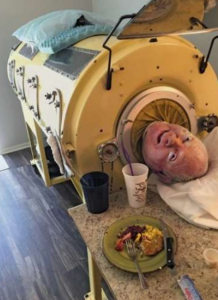76-Year-Old Man, Paralyzed from Polio at 6, Was One of the Last People with an Iron Lung: “My Life Is Incredible”
In a small home tucked away in Dallas, Texas, the sound of steady hissing and whooshing once echoed day and night — a rhythmic breath that didn’t come from lungs but from a machine older than most modern hospitals. Inside that machine lived Paul Alexander, a man who defied every medical prediction, social limitation, and technological barrier life could throw at him. At 76, he was one of the last people in the world living in an iron lung — and according to him, life was nothing short of “incredible.”
A Tragedy at Age Six
In 1952, at just six years old, Paul Alexander contracted poliomyelitis during one of the worst polio outbreaks in American history. Within days, he was unable to move or breathe on his own. Doctors weren’t hopeful. He was quickly placed in an iron lung — a massive metal cylinder that enveloped his body, leaving only his head exposed, and helped him breathe through negative pressure.
Few expected Paul to live more than a few days.
But Paul defied that timeline. Day turned to week, then month, then year. And soon, the boy who wasn’t supposed to make it out of the hospital became the man who would redefine resilience.
The Iron Lung: A Machine of Survival
The iron lung — a mechanical respirator first developed in the late 1920s — had saved thousands of lives during the height of the polio epidemic. By the 1960s, however, the widespread use of the polio vaccine rendered the machines obsolete. Hospitals phased them out. Manufacturers stopped making parts. Yet Paul, whose diaphragm remained paralyzed, still relied on the machine that had saved his life.
Unlike modern ventilators that use intubation, the iron lung created negative air pressure around a person’s torso, causing the lungs to expand and contract — effectively simulating natural breathing. Paul could spend hours outside the lung using a technique called “glossopharyngeal breathing,” or “frog breathing,” but most of his day — and every night — was spent inside the yellow capsule that had become his companion, his protector, and in some ways, his home.
“I Never Let It Stop Me”
Rather than allow his paralysis and confinement to define him, Paul made a decision early on: he was going to live.
He taught himself to speak with clarity while inside the lung, using his voice as his most powerful tool. He demanded education, and despite initial resistance from school officials, eventually earned his high school diploma from home. From there, he did what few thought was possible — he attended college, graduated from the University of Texas, and even earned a law degree.
Paul practiced law for years, using a stick held in his mouth to type and flip pages. He also wrote an autobiography — “Three Minutes for a Dog” — which took him over a decade to complete, typed letter by painstaking letter. Every word was proof that physical limits are not the same as human limits.
“I may live in a machine,” he once said, “but I’m more free than most people.”
A Life of Love, Loneliness, and Laughter
Paul never married. His condition made romantic relationships difficult, though not impossible. Over the years, he had close friendships, cherished neighbors, and even a few romances. But it was the companionship of his dog and the loyalty of close caregivers that carried him through.
He often joked that his dog, a golden retriever named Maggie, had more freedom than he did — “but less ambition.”
Visitors to Paul’s home were often struck by his humor. He was sharp, witty, and unapologetically direct. “Most people,” he once told a reporter, “complain about traffic. I haven’t been in a car in 30 years. You learn to prioritize what matters.”
He also connected with thousands of people online through YouTube videos, interviews, and even TikTok clips posted by fans and volunteers. In a world obsessed with instant gratification, Paul became a quiet icon of endurance.
Fighting to Save His Machine
By the 2010s, Paul’s iron lung was a relic — one of only a handful still functioning in the world. No company made parts anymore. At one point, a vital rubber diaphragm split, threatening his survival. His plea for help went viral, and a generous community of engineers, medical historians, and fans sprang into action.
They located old parts. Some reverse-engineered new components. Volunteers helped maintain the lung, change filters, and keep the metal beast humming. It was a reminder that sometimes it takes a village — or the internet — to keep one man breathing.
“My Life is Incredible”
To many, Paul’s life might seem like a story of limitation. But to Paul, it was one of endless possibility.
“I graduated from college. I became a lawyer. I wrote a book. I’ve loved people and been loved. I’ve traveled in my own way. I’ve lived,” he said in a 2023 interview. “How many people can say that?”
He never asked for pity. Instead, he asked for perspective. “Everyone thinks they’re stuck,” he once mused. “But I’ve been stuck in the same place for 70 years — and I’ve still moved mountains.”
His message was clear: Life’s value is not measured in steps taken, miles traveled, or breaths drawn without help. It’s measured in what you do with the life you’ve been given.
A Legacy of Strength
Paul Alexander passed away in early 2024. He died peacefully, surrounded by the gentle rhythm of the machine that had cradled him through decades of joy, struggle, and triumph.
His story continues to inspire those facing adversity — from patients battling chronic illness to young people feeling stuck in the digital age.
For Paul, every breath was hard-earned. Every smile, a rebellion. Every day, a victory.
And every person who hears his story leaves changed.
Not by sadness — but by awe.

